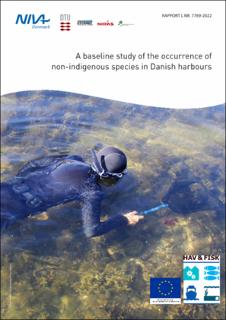| dc.contributor.author | Andersen, Jesper Harbo | |
| dc.contributor.author | Kallenbach, Emilie | |
| dc.contributor.author | Kjeldgaard, Mathias Brink | |
| dc.contributor.author | Knudsen, Steen Wilhelm | |
| dc.contributor.author | Eikrem, Wenche | |
| dc.contributor.author | Fagerli, Camilla With | |
| dc.contributor.author | Oug, Eivind | |
| dc.contributor.author | Dale, Trine | |
| dc.contributor.author | Thaulow, Jens | |
| dc.contributor.author | Gitmark, Janne Kim | |
| dc.contributor.author | Hobæk, Anders | |
| dc.contributor.author | Green, Norman Whitaker | |
| dc.contributor.author | Hesselsøe, Martin | |
| dc.contributor.author | Støttrup, Josianne | |
| dc.contributor.author | Kuhn, Jesper | |
| dc.contributor.author | Bekkevold, Dorte | |
| dc.contributor.author | Jacobsen, Lars Magnus Wulf | |
| dc.contributor.author | Møller, Peter Rask | |
| dc.contributor.author | Olesen, Christian Aakjær | |
| dc.contributor.author | Carl, Henrik | |
| dc.contributor.author | Stuer-Lauridsen, Frank | |
| dc.date.accessioned | 2022-10-06T13:17:39Z | |
| dc.date.available | 2022-10-06T13:17:39Z | |
| dc.date.created | 2022-10-06T08:01:40Z | |
| dc.date.issued | 2022 | |
| dc.identifier.isbn | 978-82-577-7505-6 | |
| dc.identifier.issn | 1894-7948 | |
| dc.identifier.uri | https://hdl.handle.net/11250/3024342 | |
| dc.description | Project Manager/Main Author Jesper H. Andersen | en_US |
| dc.description.abstract | We report the first ever nation-wide study of the occurrence of non-indigenous species in Danish harbours. The sampling was car-ried out using both conventional and biomolecular methods (eDNA). In total, 16 harbours were covered – Esbjerg and Aarhus, the two largest harbours in Denmark, with intensive sampling and 14 harbours with a reduced programme. 26 non-indigenous species were recorded using conventional sampling and 13 species were recorded using eDNA-based methods. Excluding overlapping rec-ords, we have recorded a total of 34 non-indigenous species in the 16 harbours studied. Based on the results, we conclude the following: 1) more non-indigenous species are found in the western parts of Denmark (North Sea region) then in the eastern parts (Baltic Sea), and 2) a few species previously unseen in Danish marine waters were recorded, i.e. the two bristle worms Eteone het-eropoda (fam. Phyllodocidae) and Streblospio benedicti (fam. Spionidae). Further, we provide a proof-of-concept regarding the overarching objectives of the MONIS 1-3 projects and the eDNA-based test systems developed. The results constitute a baseline for future studies in Danish ports and other hotspot areas. | en_US |
| dc.language.iso | eng | en_US |
| dc.publisher | Norsk institutt for vannforskning | en_US |
| dc.relation.ispartof | NIVA-rapport | |
| dc.relation.ispartofseries | NIVA-rapport;7769-2022 | |
| dc.subject | Overvåking | en_US |
| dc.subject | Monitoring | en_US |
| dc.subject | EDNA | en_US |
| dc.subject | EDNA | en_US |
| dc.subject | Havstrategidirektivet | en_US |
| dc.subject | Marine Strategy Framework Directive | en_US |
| dc.subject | Ikke hjemmehørende arter | en_US |
| dc.subject | Non-indigenous species | en_US |
| dc.title | A baseline study of the occurrence of non-indigenous species in Danish harbours | en_US |
| dc.type | Research report | en_US |
| dc.description.version | publishedVersion | en_US |
| dc.rights.holder | © Norsk institutt for vannforskning/Norwegian Institute for Water Research. The publication can be cited freely if the source is stated. | en_US |
| dc.subject.nsi | VDP::Matematikk og naturvitenskap: 400 | en_US |
| dc.subject.nsi | VDP::Mathematics and natural scienses: 400 | en_US |
| dc.source.pagenumber | 83 | en_US |
| dc.source.issue | 7769-2022 | en_US |
| dc.identifier.cristin | 2058972 | |
| cristin.ispublished | true | |
| cristin.fulltext | original | |
